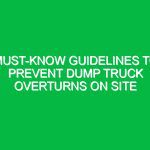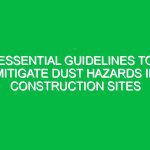“`html
Essential Dust Guidelines: Avoid These Common Health Risks Now
Introduction
Good morning team! Today, we’re going to discuss an often-overlooked aspect of Workplace Safety: dust management. It’s crucial for us to understand the health risks associated with dust exposure and the Best Practices to mitigate them. Why is this important? Well, dust isn’t just a nuisance—it can pose serious health risks, including respiratory problems, allergies, and even long-term diseases. Let’s ensure that we keep our work environment safe and healthy by adhering to these essential dust guidelines.
Understanding Essential Dust Guidelines
Essential dust guidelines refer to the practices and protocols aimed at minimizing dust exposure in the workplace. Dust can originate from various sources, including construction materials, woodwork, metal fabrication, and even daily cleaning activities. Understanding these guidelines is vital as they help us identify potential Hazards and take preventive measures to protect our health.
Many employees believe that dust is harmless and that regular cleaning is sufficient to manage it. However, prolonged exposure can lead to serious health issues, including chronic obstructive pulmonary disease (COPD), asthma, and silicosis. It’s essential to debunk these misconceptions and recognize that effective dust management is a critical component of Workplace Safety.
Key Hazards, Risks, and Safety Considerations
Several key hazards are associated with dust in the workplace:
- Respiratory Issues: Inhalation of fine dust particles can cause significant damage to the lungs and respiratory tract.
- Skin Irritation: Certain types of dust, such as silica or wood dust, can lead to skin allergies or irritation.
- Reduced Visibility: Dust accumulation can create unsafe working conditions by obstructing visibility.
- Fire Hazards: In industries like woodworking, dust can be highly flammable, posing fire risks if not properly managed.
Ignoring these hazards can lead to severe consequences, including workplace accidents, increased medical costs, and decreased productivity. By recognizing these risks, we can take proactive steps to create a safer work environment.
Best Practices, Procedures, & Actionable Advice
Now that we understand the risks associated with dust exposure, what can we do about it? Here are some Best Practices to follow:
- Use Proper Personal Protective Equipment (PPE): Always wear appropriate PPE, such as masks, gloves, and goggles, to prevent inhalation and contact with dust.
- Implement Engineering Controls: Use exhaust ventilation systems and dust collection devices to minimize dust generation at the source.
- Regular Cleaning Protocols: Establish a routine cleaning schedule using appropriate methods, such as wet mopping or vacuuming with HEPA filters, to reduce dust accumulation.
- Training and Awareness: Conduct regular Training sessions to educate employees about the importance of dust control and the specific hazards they may encounter.
For instance, let’s consider a recent incident at another facility where inadequate dust control led to a significant respiratory health issue among workers. By implementing proper dust management practices, such as regular air quality monitoring and enhanced PPE usage, they were able to reduce these incidents dramatically.
Regulations, Standards, and Compliance
Compliance with Safety Regulations is not just a legal obligation; it’s a commitment to our health and well-being. Relevant standards include:
- OSHA Guidelines: The Occupational Safety and Health Administration (osha) sets permissible exposure limits (PELs) for various types of dust.
- ISO Standards: The International Organization for Standardization (ISO) provides guidelines for managing Workplace Health and safety.
- Company-Specific Policies: Always adhere to your company’s specific safety protocols regarding dust management.
Staying compliant with these regulations not only protects us but also fosters a culture of safety within our organization. Remember, it’s not just about meeting the minimum requirements—it’s about striving for excellence in Workplace Safety.
Employee Engagement & Discussion
Now, I’d like to open the floor for discussion. What safety challenges have you encountered related to dust in your work areas? Have you noticed any specific situations where dust management could be improved? Let’s share our experiences so we can learn from each other and enhance our safety practices.
Conclusion & Key Takeaways
In summary, understanding and adhering to essential dust guidelines is vital for maintaining a safe and healthy workplace. Remember to:
- Recognize the health risks associated with dust exposure.
- Implement best practices for dust control.
- Stay informed about regulations and compliance.
- Engage in discussions about safety challenges and solutions.
Let’s commit to prioritizing these practices and ensuring the safety of ourselves and our colleagues. Thank you for your attention today and for your ongoing commitment to Workplace Safety. Together, we can make a difference!
“`


